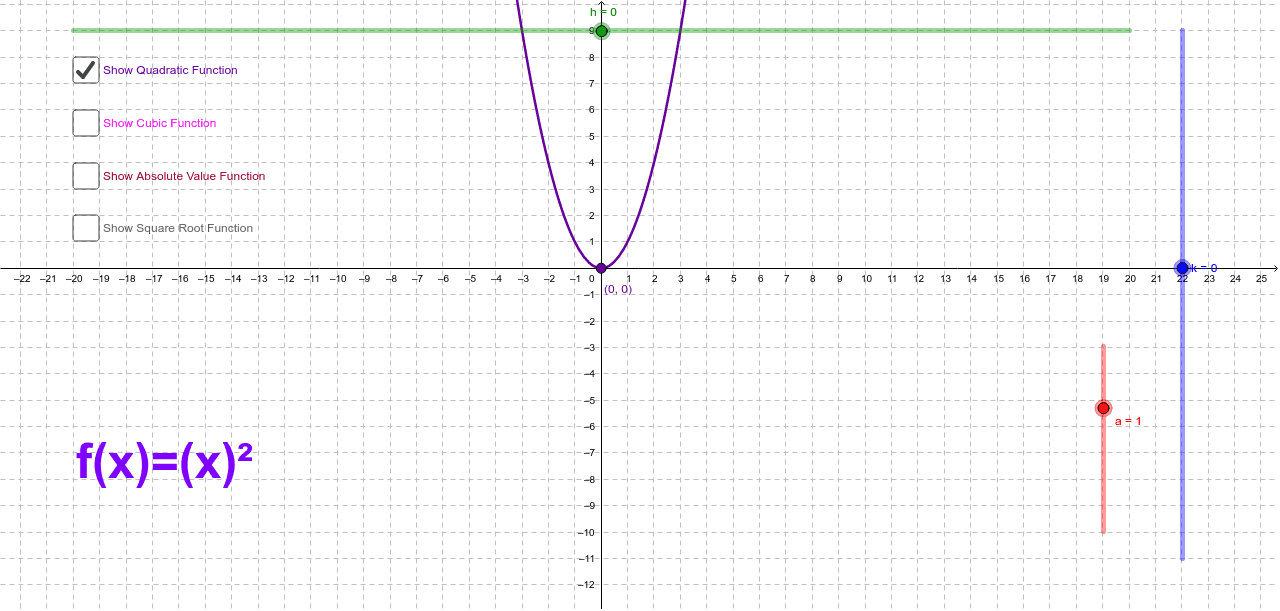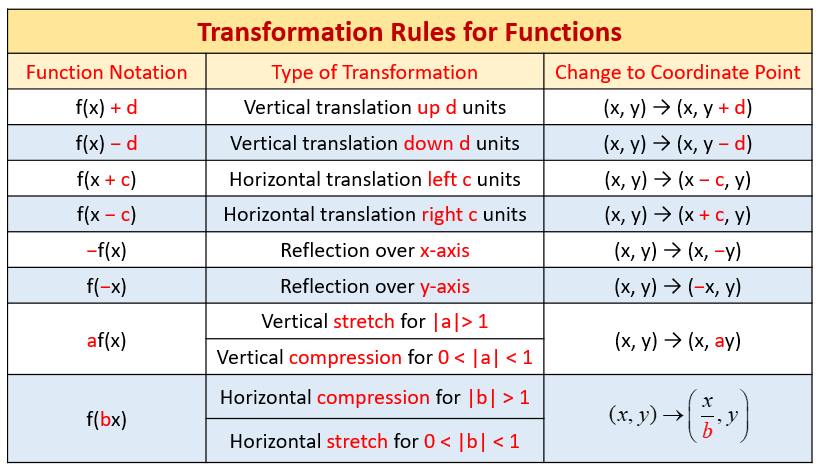Which Describes How to Graph by Transforming the Parent Function
Absolute value transformations will be discussed more expensively in the Absolute Value Transformations Section. Gx1 x4 3 d.

Interpreting Function Graphs Matching Activity Print And Digital Word Problems Math Word Walls Graphing Linear Equations
Find f0 7 6 141 O 141 x.

. On this lesson I will show you all of the parent function graphs parent function definition and their domain and rangeFor more MashUp Math content visit. Since 8 is adding within the square root there is a horizontal translation of 8 units to the left. The graph of reciprocal parent function fx1x is shifted 3 units up and 4 units to the right to create the graph of gx.
Reflect the parent function over the x-axis and translate it 8 units to the left. Then subtract 2 from both sides to get y 2 log 3 x 1. Given a polynomial p x and constant real numbers c and a.
Lets go ahead and graph x 3 first. Gx RootIndex 3 StartRoot x minus h EndRoot k h 1 k -2. Hide Plot.
This website uses cookies to ensure you get the best experience. Transformations and Parent Functions Complicated examples Sketch the following ftnctions. 0 If f x is the parent function afbx - c d is the transformed function where 6 0 5 6 a is the b is the c is the d is the stretch compression horizontal shift vertical shift To check your graph select some points.
Which describes how to graph hx -RootIndex 3 StartRoot x EndRoot 3 using transformations of the parent function. Compare and list the transformations. Describe how to sketch the graph ofy -tan2x 3 using the parent function.
On which interval is the function decreasing. The t-charts include the points ordered pairs of the original parent functions and also the transformed or shifted points. Then graph the transformed function using a solid curve and state the domain and range using interval notation.
Which equations transform the parent secant graph to the parent cosecant graph. The basic transformations are vertical and horizontal shifts and reflections about the x and yaxis. Vertical Compression or Stretch.
Get the logarithm by itself. These transformations include horizontal shifts stretching or compressing vertically or horizontally reflecting over the x or y axes and vertical shifts. When a a is greater than 1 1.
Y sec x - pi2 Describe how to sketch the graph ofy 2sec x - 3 using its reciprocal function. Which transformations are needed to change the parent sine function to the sine function below. The graph of f x x is reflected across the x-axis and translated to the right 6 units.
Which statement about the domain and range of each function is correct. Stretch the graph of y cos x so the amplitude is 2. Just like quadratics polynomial functions can be graphed using transformations of a known graph.
Which statement describes how to transform the graph of fx x to get fx 3 x. What function is gx. Compress the graph horizontally.
Compressing and stretching depends on the value of a a. The parent function is. Furthermore all of the functions within a family of functions can be derived from the parent function by taking the parent functions graph through various transformations.
The function f x c is given with gx kx. Use the transformations to graph h x as well. If your function is.
State the parent function and describe all transformations. Gx1 x-3 4 c. Y x2 y x 2.
6 points f x -log2 x-2 - 3 10T 9 8 7 5 4 3 2 1 10007-6-5-43210 1 2. When a a is between 0 0 and 1 1. Graph the parent function using a dashed curve.
Move the graph of the parent function 3 units down. Draw vertical asymptotes where the graph crosses the x-axis. Start by graphing the tangent function.
Algebra questions and answers. Triple each y-value of the parent function. The first two transformations are translations the third is a dilation and the last are forms of reflections.
Reflect over the horizontal axis and then translate the graph up 3 units. First rewrite the equation as y log 3 x 1 2. F x x 3 3 1 displaystyle f x -x3 3-1 it has a left shift 3 units.
Divide each y-value of the parent function by 3. Determine the values of h and k in the equation of gx. Which of the following equations would transform the tangent graph to the parent cotangent graph.
The redrawn basic graph will shift to the right 2 units. Gx1 x3 4 b. Which describes how to graph hx -3x 8 by transforming the parent function.
Hence we need to translate x 3 one unit to the right and one unit downward. Move the graph of the parent function 3 units up. F x x 2 2 3 displaystyle f x- x-2 23 it has a right shift 2 units.
Free Function Transformation Calculator - describe function transformation to the parent function step-by-step. Solution Lets break down h x first. Start by graphing the cosine function.
Therefore to graph the given function reflect the parent function over the x-axis and translate it 8 units to the left. Since fa a what is. The graph of f x x is transformed to g x x 1 - 7.
Lets go ahead and remove the parent function to show h x by itself. P xc is a vertical shift of the graph of p x by c units up so the function. Identify the graph of gx.
H x x 1 3 1. Which is the graph of the function fx -x. Which of the following describes the transformation of from the parent.
The parent function fx x3 is transformed to gx x 13 4. We then apply the transformations. 3-7 7 6-6 y-intercept.
The following steps show you how to do just that when graphing f x log 3 x 1 2. The domain of the transformed function is the same as the parent function but the ranges of the functions. How is the graph of mc020-1jpg related to its parent function mc020-2jpg.
Select all that describe how the graph of y-2cotx4-3 differs from that of y cotx. By using this website you agree to our Cookie Policy. The given function is.
Since there is a negative multiply the transformed function there is a reflection in the x-axis. Change the log to an exponential expression and find the inverse function.

Transformations Of Graphs A H K Geogebra

The Parent Function Graphs And Transformations Youtube

Parent Functions And Their Graphs Video Lessons Examples And Solutions
No comments for "Which Describes How to Graph by Transforming the Parent Function"
Post a Comment